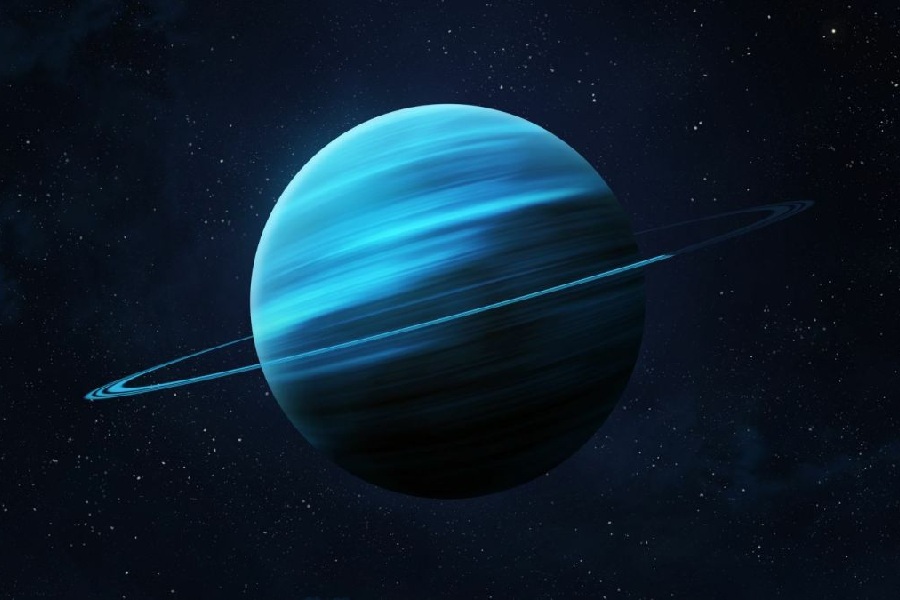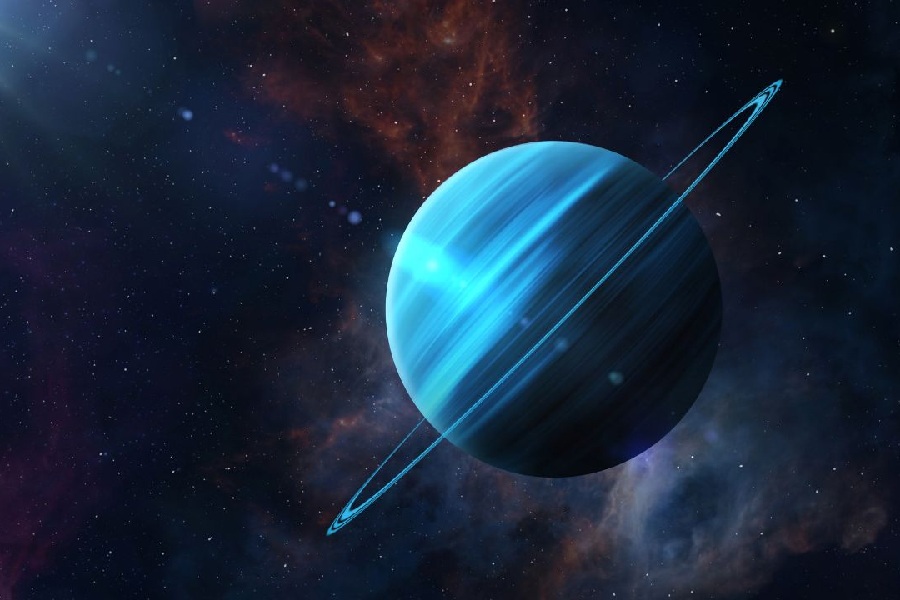Gazing at Uranus through a telescope, it seems like a tiny cold orb. Yet compared to our Sun up close, how their sizes stack up may surprise you. So, is it Uranus compared to the Sun? How far is Uranus from the Sun?
This article delves into a clear comparison between two celestial bodies. The significant differences in their measurements unveil fascinating insights into the nature of the icy seventh planet.
We will also shed light on the immense characteristics of the life-sustaining solar furnace. Let’s highlight key distinctions between the Sun and Uranus.

Uranus Compared to the Sun
Uranus is much smaller than the Sun. The Sun is a massive, hot star at the center of our Solar System, while Uranus is a gas-giant planet. The Sun is about 109 times wider than Uranus and 330,000 times heavier.
Uranus orbits the Sun, along with other planets, and it gets its light and heat from the Sun. In comparison, the Sun is a powerful source of light and heat, providing energy to all the planets, including Uranus.
Also, what is the distance from Uranus to the Sun? The average distance from Uranus to the Sun is approximately 1.8 billion miles (2.9 billion kilometers). However, planetary distances in our Solar System can vary due to the elliptical shape of their orbits.
Exploring key measurement differences
Uranus is the 7th planet, which is a small, icy world orbiting our Sun that powers the Solar System. If you compare Uranus and the Sun, there is a gigantic difference in size. This contrast shows how tiny Uranus is next to the huge Sun.
It also highlights their very different natures, one is a frozen outer planet, the other a blazing hot star heating the planets. Looking at how enormously the Sun outweighs little Uranus demonstrates extremes from outer orphan planets to raging central stars.
Comparing physical and operational variations
Uranus relies on the Sun’s warmth and light, which is generated through nuclear fusion. In contrast, Uranus is a frozen planet. The significant differences in their structures emphasize the vast contrasts between the two celestial bodies.
These differences emphasize the immense impact the Sun has on planets like Uranus. The vast gaps between them serve as a reminder of the Sun’s colossal size and powerful energy source.
Size Disparities: Uranus vs. the Sun
The Sun is like a cosmic giant, over 100 times wider than little Uranus, even though Uranus is the third heaviest planet in our neighborhood. Standing next to the Sun, Uranus seems almost invisible.
Using clear measurements helps understand the huge difference in their sizes. It’s like comparing a tiny planet to a gigantic star. Looking at the actual sizes, we see massive gaps that separate stars from even the biggest planets. It’s like comparing a pebble to a mountain in the vast cosmic landscape.
Importance of celestial size differences
The size differences between stars and planets like Uranus play a big role in their unique characteristics. For example, where they get their energy, how they generate magnetism and the kind of radiation they produce.
Think of it as comparing tiny Uranus to the huge Sun. It helps see and understand the essential qualities that make planets and stars different. When scientists look at their sizes, they can reveal deeper insights into how these celestial bodies work.
The huge gaps in scale between little Uranus and the giant Sun highlight key differences that set them apart as different types of celestial beings. This kind of comparison gives us a closer look at the basics that distinguish planets and stars.

Physical Traits
Physical traits of Uranus
Uranus is the 3rd largest planet, with an equatorial diameter of 51,118 km (31,763 miles) and a mass 17 times that of Earth. This makes up a volume 63 times greater than Earth.
As a cold ice giant, Uranus’ average temperature is -216 degrees Celsius. This extreme cold gives way to increasing pressures building toward its higher density, 15.2 g/cm3 fluid interior.
Size, average temperature, and density
Uranus is notably cold and expansive, measuring about four times wider than Earth. Its atmosphere is primarily composed of methane, contributing to its super cold average temperature of -216 degrees Celsius.
In addition to its frigid temperatures, Uranus is a heavyweight in terms of mass, being 17 times more massive than Earth. Combined with its larger size and icy composition, this earns Uranus the title of the coldest planet in our Solar System. The unique combination of its massive volume and icy temperatures results in a low density, making Uranus a distinct and cold member of our cosmic family.
Average Temperature of Uranus Compared to the Sun
Picture Uranus as the chilly cousin in our cosmic family, boasting an icy average temperature of -216 degrees Celsius on its outer layers. This frosty atmosphere results from its distance from the Sun, receiving only minimal sunlight. Additionally, Uranus’s air is filled with methane, contributing to its coolness.
Now, let’s focus on the Sun, the cosmic hotshot. It’s a blazing ball of heat with an average surface temperature exceeding 5,500 degrees Celsius.
Delving deeper into its core, the Sun reaches a scorching 15 million degrees Celsius, thanks to the remarkable process of nuclear fusion. So, while Uranus maintains its cool demeanor, the Sun acts as our cosmic heater, bringing the heat to the celestial party.
Contrasting Density Characteristics
The average density of Uranus is significantly lower than that of the Sun. While Uranus is a giant gas planet with an approximate density of 1.27 grams per cubic centimeter, the Sun, as a massive star, has a much higher average density of about 1.41 times 10^3 grams per cubic centimeter.
The contrast in density between Uranus and the Sun is substantial. Despite being over 800 times larger in terms of volume, Uranus has a lower overall mass than the Sun. This low density contributes to Uranus’ cloud-like appearance.
In contrast, the Sun’s high density is a result of its immense gravitational pressure and the intense nuclear fusion reactions occurring in its core. The Sun’s density is consistent throughout its structure, providing stability and facilitating the continuous release of energy.
Therefore, the difference in average densities highlights the distinct nature of these celestial bodies—Uranus, a low-density gas giant, and the Sun, a high-density, luminous star.
Orbital Periods for Both Bodies
The concept of an orbital period is more applicable to planets like Uranus than the Sun. An orbital period refers to a celestial body’s time to complete one orbit around another. Uranus’s orbital period around the Sun is approximately 84 Earth years, given its greater distance from the Sun than Earth.
On the other hand, the Sun doesn’t orbit around any specific body in the Solar System. Instead, it serves as the central gravitational anchor around which all other celestial bodies, including Uranus, orbit. The Sun’s position is static in the center of our Solar System, and its immense gravitational pull keeps the planets, like Uranus, in orbit around it.
Overall, while Uranus has an orbital period of approximately 84 Earth years around the Sun, the Sun itself doesn’t have a traditional orbital period. It is the gravitational focal point around which all planets revolve in our Solar System.
Differences in upper atmospheres and temperature
Uranus differs from the Sun in composition and structure. Uranus is a gas giant with a complex upper atmosphere with distinct cloud layers, including methane. Its extreme temperature variations range from frigid upper-atmosphere temperatures of approximately -224 degrees Celsius to a high-temperature core due to gravitational compression.
In contrast, the Sun, a G-type main-sequence star, lacks a solid surface and possesses no defined atmosphere. Instead, it showcases various outer layers, such as the photosphere and chromosphere, where phenomena like sunspots and solar flares occur.
The Sun’s core reaches millions of degrees Celsius, contributing to its role as a massive and luminous celestial body at the center of our solar system. These disparities highlight the diverse characteristics of Uranus and the Sun within our cosmic neighborhood.
Conclusion
Exploring Uranus compared to the Sun contrasts, their extreme divergences indicate what makes a planet different from a star. The frigid ice giant Uranus contrasts extremely with our intensely hot governing star, the Sun. Their differences showcase what makes a planet so unmistakably different from an average stellar ball of fusing gas.
So, Uranus relies on external sources, while our Sun is incredibly self-contained and independent. Our Sun, burning on its own, exceeds the volume of planet Earth over 100,000 times. Understanding these differences between solar dynamos and dependent distant worlds like Uranus enhances our insight!
